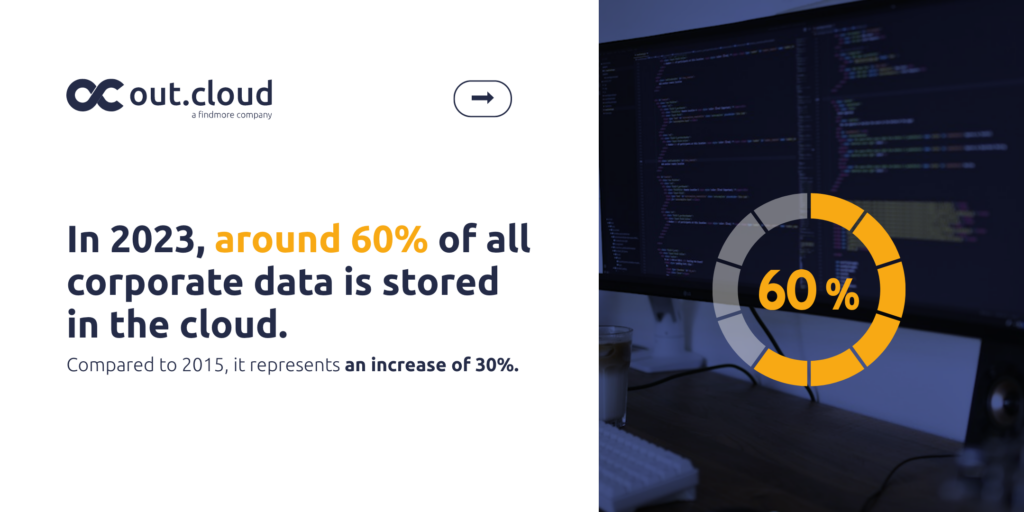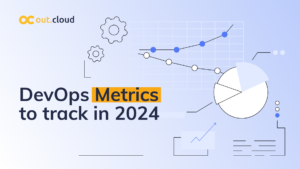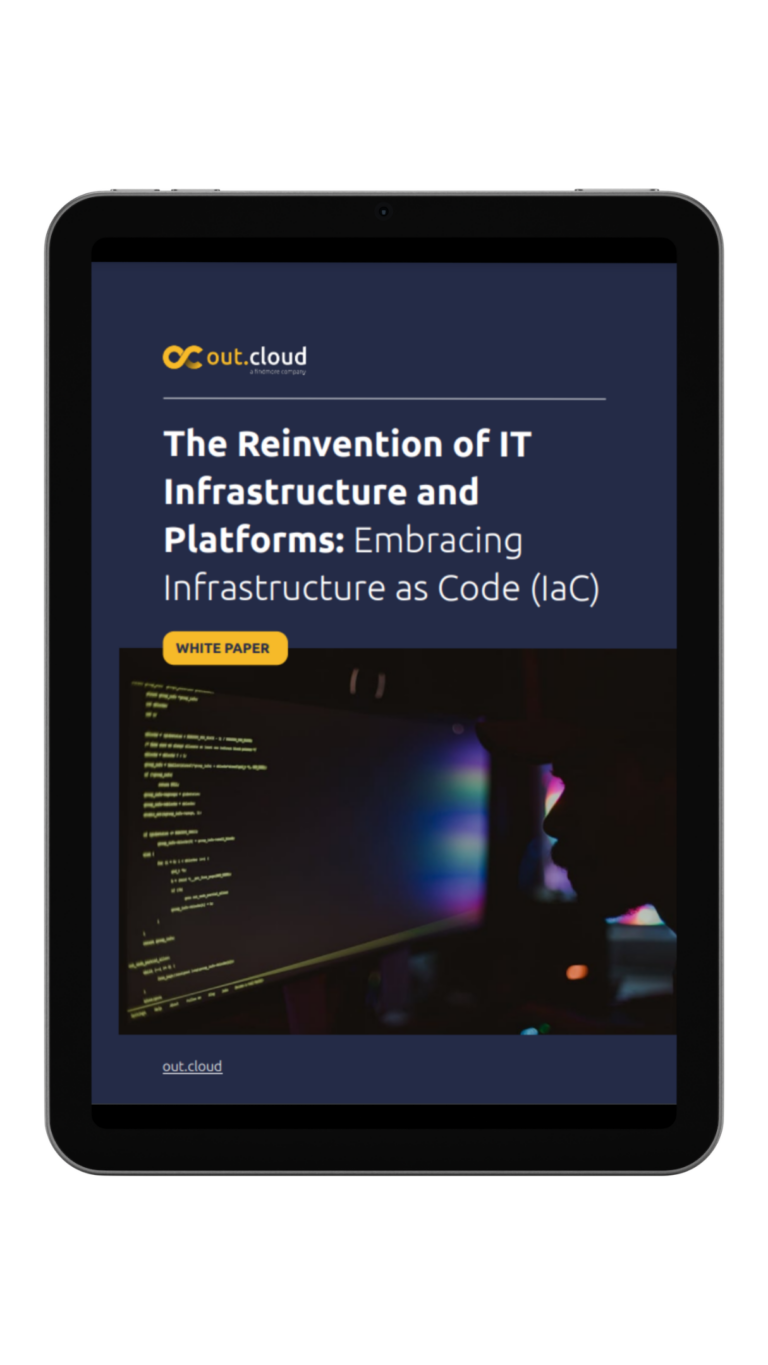In 2023, the corporate world is witnessing a revolutionary shift in data management. With approximately 60% of all corporate data now stored in the cloud, up significantly from 30% in 2015, the trend towards cloud adoption is clear and compelling.
(Percent of Corporate Data Stored in the Cloud)

This proves that more and more companies are choosing to migrate to the cloud as a solution for their business. But, is moving to the cloud the right decision for your organization? We tell you all about it!
Before diving into the world of cloud solutions and its potential, it’s important to first understand what it is.
What is Cloud Migration?
In simple terms, cloud migration is the process of moving components, data, and applications that are hosted on servers inside an organization to the cloud. Simple enough, right?
This solution is a relatively recent service on the market, but it quickly became the desired approach for businesses to store data. Generally, organizations have struggled to grow their information infrastructures. However, the efficiency and scalability that the cloud brought, provided more than an added option, it delivered the ideal solution. Considering this option is important, as well as determining what is needed or where to start to take on such an endeavor.
Why Migrate to the Cloud?
Deciding to migrate is, for one, cost-effective, and with any business, managing investment vs cost is key. Take into consideration that by maintaining your data in a data warehouse on-site you are responsible for managing the entire infrastructure, its needed support, and overall maintenance, which in time can become very costly.
As mentioned earlier, scalability is an important feature and a major benefit, as it allows businesses to independently manage the speed at which they expand without concerning themselves with issues like space.
When deciding about migrating, security is a clear advantage. Keep in mind that providers with data warehouses are responsible for top-notch security and provide an extremely skilled and experienced team dedicated to this. In other words, the right provider assures industry-standard compliance requirements, as well as certifications such as SOC 2, ISO27001, HIPAA, and PCI.
Lastly, support. As expected, there can be some complexity when it comes to data and cloud migration. But don’t worry, Out.Cloud have product engineers that provide support whenever needed.
How does the cloud migration process work?
To ensure a successful transition from on-premises infrastructure to cloud-based solutions, it is important to follow 4 essential steps: Business Strategy; Infrastructure; Security; and Operations. Let’s break down these steps!
1. Business Strategy
During the business strategy phase, it’s important that all stakeholders, including business leaders, IT teams, and other relevant parties, are involved and collaborate to develop a comprehensive cloud adoption strategy. The primary objective is to align the migration process with the organization’s overall business goals and requirements.
Key activities in this phase may include:
- Evaluating the existing infrastructure: Including, applications, hardware, software, and data. This evaluation helps identify the components that can be migrated to the cloud and any potential challenges.
- Identifying business drivers: Understanding the specific business drivers that motivate the move to the cloud, such as cost optimization, scalability, agility, or improved collaboration.
- Defining objectives: Setting clear objectives for the migration process. Ex.: reducing operational costs, increasing performance, or improving security.
- Establishing a roadmap: Develop a step-by-step plan that outlines the timeline, milestones, resource allocation, and dependencies for the migration process.
2. Infrastructure
In most cases, numerous aspects of the existing architecture, storage, and databases will need to be adapted or modified when moving to the Cloud.
This phase involves several activities, including:
- Deciding if Your Applications are Cloud-Ready: Evaluating applications and determining their suitability for migration. Some applications may need modifications or redesign to work optimally in the cloud.
- Ensuring compatibility with the Cloud: Making necessary changes to applications, databases, and infrastructure components to ensure compatibility with the cloud environment. This may involve leveraging cloud-native services and architectures to maximize benefits.
- Data migration: Planning and executing the transfer of data from on-premises systems to the cloud, ensuring data integrity, security, and minimal downtime.
In Out.Cloud, to accelerate this procedure, we assembled several templates, so you can automate and repeat the same processes to migrate applications to the cloud. Send us a message to know more about this.
3. Security
The security phase involves collaborating with the security team and cloud provider to understand security needs and address potential risks.
Key activities include:
- Security assessment: Assessing the existing security controls and identifying any gaps or vulnerabilities that need to be addressed during migration.
- Identity and access management: Developing strategies for managing user identities, access controls, and authentication mechanisms in the cloud environment.
- Data protection and privacy: Establishing measures to protect sensitive data, including encryption, data classification, and compliance with applicable regulations.
- Incident reporting and response: Setting up processes to detect, report, and respond to security incidents, ensuring timely mitigation and adherence to incident response best practices.
- Compliance and governance: Ensuring compliance with relevant industry standards, regulations, and organizational policies in the cloud environment.
4. Operations
The operations phase focuses on managing, monitoring, and optimizing the cloud systems after migration.
This phase involves ongoing activities such as:
- Cloud system management: Monitoring the performance, availability, and reliability of cloud resources, including virtual machines, storage, and networking components.
- Cost optimization: Identifying opportunities to optimize cloud costs by rightsizing resources, utilizing reserved instances, implementing efficient scaling strategies, and monitoring spending patterns.
- Continuous improvement: Iteratively improving the cloud infrastructure and applications based on user feedback, performance metrics, and emerging technologies.
- Incident management: Handling and resolving incidents that may arise in the cloud environment, ensuring minimal disruption to business operations.
- Capacity planning: Proactively monitoring resource utilization and planning for future growth or scalability requirements.
- Patching and updates: Managing the application of patches, updates, and security fixes to ensure the cloud infrastructure remains secure and up to date.
Remember, each organization’s cloud migration journey is unique, and it is crucial to adapt these steps to suit your specific needs and challenges. With the right approach and a trusted partner, organizations can navigate the complexities of cloud migration and reap the rewards of a modern, agile, and scalable IT infrastructure. See how we can help you migrate to the cloud.
Cloud Migration: A Solution to Problems
Without a doubt, the introduction of these serverless resources has provided a window to the future, foreseeing a solution to problems concerning managing big data and cyber-security.
For many organizations, the choice to migrate to the cloud has reshaped and transformed how technology is used and information is stored, but also how it’s shaped thanks to emerging technologies, such as Artificial Intelligence (AI).
More than ever, cloud computing must be considered, and migrating to a cloud service is becoming a current choice for many organizations. This decision has proven to be extremely beneficial, providing a major impact on efficiency, greater flexibility, and equally important, a strategic advantage, from increasing productivity to automation.
The Cloud sounds great, what’s next?
If you are considering migrating your organization to the Cloud, or if you still have questions regarding the migration process, send us a message, so we can help you.






